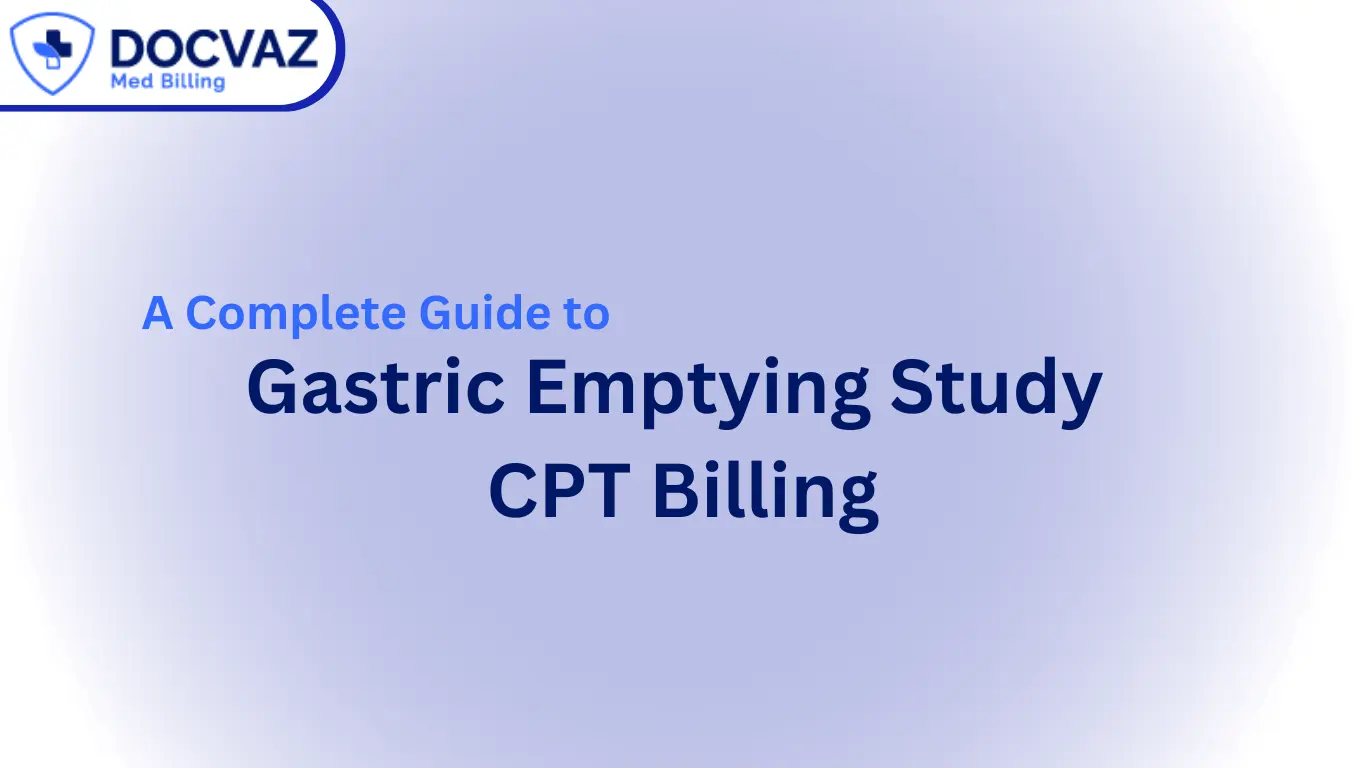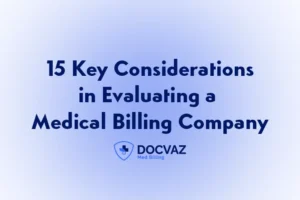A gastric emptying study is a diagnostic imaging test that evaluates how quickly food leaves the stomach. It plays a crucial role in identifying gastrointestinal disorders such as gastroparesis, functional dyspepsia, or other motility issues. By using a radiolabeled meal and imaging over a period of time, healthcare providers can assess the stomach’s ability to process and pass food to the small intestine.
In medical billing, assigning the correct CPT (Current Procedural Terminology) code is essential for ensuring providers receive appropriate reimbursement and that claims comply with payer regulations. DocVaz medical coding services ensure accurate CPT coding, streamlining the billing process and helping prevent denials, delays, and compliance issues. Properly billing for a gastric emptying study ensures that the facility or practitioner is compensated for their work while maintaining transparency and accuracy in patient care documentation.
Section 1: What is a Gastric Emptying Study?
1.1 Definition and Purpose
A gastric emptying study is a nuclear medicine procedure used to evaluate how efficiently the stomach moves food into the small intestine. It is particularly valuable in diagnosing gastrointestinal motility disorders, where the normal movement of the stomach muscles may be impaired.
This test is commonly ordered for patients experiencing chronic nausea, vomiting, abdominal bloating, or early satiety, which could be symptoms of gastroparesis—a condition characterized by delayed stomach emptying. Other conditions that may prompt a gastric emptying study include functional dyspepsia, post-surgical complications, or diabetic gastric dysfunction.
1.2 Procedure Overview
Gastric emptying studies typically involve the patient consuming a standardized meal that contains a small amount of radioactive material, which can be tracked using a gamma camera.
There are three main types of gastric emptying studies:
- Solid Meal Study: The most common, typically using a radiolabeled egg sandwich.
- Liquid Meal Study: Uses a radiolabeled liquid, often performed when solid studies are not conclusive.
- Combined Solid and Liquid Study: Provides a comprehensive view of gastric function.
Steps involved in the procedure:
- Meal Preparation and Consumption: The patient eats a radiolabeled meal under supervision.
- Imaging Intervals: Images are taken at regular intervals (typically over a 1 to 4-hour period) to observe the rate of gastric emptying.
- Data Analysis: The images are analyzed to determine how much of the meal remains in the stomach over time.
- Result Interpretation: The data is used to determine if the patient has delayed or accelerated gastric emptying, assisting in diagnosis and treatment planning
Section 2: Understanding CPT Codes for Gastric Emptying
2.1 Primary CPT Code
The primary CPT code used for billing a gastric emptying study is:
- CPT 78264 – Gastric emptying study, solid meal, imaging, and calculation of gastric emptying.
This code is typically used when a standard gastric emptying study is conducted using a solid meal, which is the most common method. The procedure involves imaging the patient’s stomach after they consume a radiolabeled meal, tracking how quickly it empties.
When to use this code:
- If the study is performed using only a solid meal (e.g., a radiolabeled egg sandwich).
- When the procedure includes imaging and calculation of gastric emptying.
- If no additional gastrointestinal transit (like small bowel or colon) is being evaluated.
2.2 Additional Relevant CPT Codes
Sometimes, additional or more advanced evaluations are required. In such cases, the following supplementary CPT codes might be applicable:
- CPT 78265 – Gastric emptying with small bowel and colon transit.
- Used when the study is extended to assess small bowel and colon motility in addition to the stomach.
- This code is typically used in complex motility disorder evaluations.
- CPT 78266 – Gastric motility study.
- This code may apply in non-standard gastric motility assessments, especially if the focus is on neuromuscular dysfunction of the stomach or post-operative gastric monitoring.
- It may be used in research or advanced diagnostic settings.
Each of these codes ensures proper billing and reflects the extent and complexity of the diagnostic study performed.
2.3 Modifiers and Units
To correctly bill for gastric emptying studies, understanding the use of modifiers and units is essential:
- Modifier -TC (Technical Component):
- Used when only the equipment, supplies, and technical staff (not the interpretation) are billed.
- Typically used when the provider is responsible for the imaging but not the analysis.
- Modifier -26 (Professional Component):
- Applied when billing only for the interpretation and report by the physician or radiologist.
- Used when the physician is not supplying the equipment or staff but is responsible for the professional service.
- Global Billing (No Modifier):
- Used when both the technical and professional components are billed together.
- Units:
- Generally, one unit is billed per complete gastric emptying study, but additional units or separate billing may apply for extended transit evaluations or multiple-day studies.
Section 3: Billing Guidelines and Documentation Requirements
3.1 Payer-Specific Requirements
When billing for gastric emptying studies, understanding the specific requirements of different payers is essential to ensure proper reimbursement and reduce claim rejections.
- Medicare vs. Private Insurance:
- Medicare often has stricter documentation rules and may require medical necessity to be clearly demonstrated.
- Private insurers vary in their policies; some may bundle services or require specific CPT codes for combined studies (e.g., gastric emptying and small bowel transit).
- Reimbursement rates and prior authorization requirements also differ between payers.
- Pre-authorization and Medical Necessity:
- Many insurance companies require pre-authorization before performing a gastric emptying study.
- Providers must submit:
- Patient symptoms and medical history.
- Previous treatments or diagnostic tests.
- Justification for the study (e.g., suspected gastroparesis).
- Failing to obtain authorization can lead to outright denial, even if the study was clinically appropriate.
3.2 Proper Documentation Practices
Accurate, thorough documentation supports billing claims and protects providers during audits or appeals.
- What to Include in Clinical Notes and Reports:
- Patient history: including presenting symptoms such as nausea, vomiting, bloating, or early satiety.
- Indication for the test: clearly explain why a gastric emptying study was ordered.
- Procedure details: the type of study (solid, liquid, or combined), the methodology used, and the timing of images.
- Results and interpretation: include the time intervals, percentage of gastric content emptied, and comparison to normal values.
- Avoiding Claim Denials:
- Incomplete or vague documentation is one of the top reasons for denial.
- Use standardized templates and ensure that every required element is documented.
- Align documentation with the ICD-10 diagnosis codes that justify medical necessity (e.g., K31.84 for gastroparesis).
- Maintain consistent terminology between clinical notes, radiology reports, and billing claims.
Section 4: Common Billing Mistakes to Avoid
4.1 Incorrect Code Usage
Using the wrong CPT code is one of the most frequent errors when billing for gastric emptying studies, often resulting in denied claims or underpayment.
- Misuse of Codes for Other GI Studies:
- Sometimes, coders mistakenly use non-specific gastrointestinal imaging codes instead of the appropriate gastric emptying codes.
- For example, using a general nuclear medicine code (e.g., CPT 78290 – gastrointestinal transit) in place of CPT 78264 can lead to rejections or delays in reimbursement.
- Mixing Up Similar Nuclear Medicine Codes:
- Codes like CPT 78265 (gastric emptying with small bowel and colon transit) or CPT 78266 (gastric motility) may be confused with CPT 78264.
- It’s important to confirm the type of study actually performed (solid, liquid, or combination) and bill accordingly.
- Always match the CPT code to the documented procedure and radiologist’s report.
4.2 Missing Modifiers or Incomplete Claims
Another common cause of billing issues is submitting claims without necessary modifiers or complete documentation.
- Impact on Reimbursement:
- Not using the correct modifiers—like -TC (technical component) or -26 (professional component)—can result in denied or reduced payments, especially when services are performed across multiple entities (e.g., hospital and physician).
- For instance, billing without modifier -26 when only interpretation was done can result in an overpayment or claim denial.
- Solutions to Ensure Completeness:
- Implement a billing checklist that includes code verification, modifier usage, and documentation requirements before submission.
- Use electronic billing systems with built-in error detection to catch missing data fields or mismatched codes.
- Ensure the clinical notes, radiology report, and claim form are all consistent and fully populated.
- Conduct regular staff training on current CPT code updates and payer-specific guidelines to reduce human error.
Section 5: Tips for Efficient CPT Billing for Gastric Emptying Studies
How technology can streamline accuracy:
- Electronic Health Record (EHR) and medical billing software can automatically validate CPT codes, ensure correct modifier use, and check claims for common errors before submission.
- Built-in coding libraries and rules-based engines help ensure that CPT 78264, 78265, and 78266 are applied appropriately depending on the procedure details documented in the clinical notes.
- Integration with PACS systems (Picture Archiving and Communication Systems) allows for faster retrieval of radiology reports and correlates with billing data.
Recommended features in billing platforms:
- Real-time code validation with payer-specific rules.
- Customizable templates for nuclear medicine and gastric motility procedures.
- Automatic modifier application (e.g., -TC, -26).
- Claim scrubbing tools that detect missing fields or mismatches before submission.
- Audit trail features that track documentation linked to each claim.
- Batch processing to handle high volumes of diagnostic procedures efficiently.
Using a reliable billing system can drastically reduce claim denials and speed up reimbursements.
5.2 Staff Training and Updates
Keeping coding and billing teams educated on code updates:
- CPT codes are updated annually, and missing new guidelines or bundling rules can result in rejected claims.
- Regular internal training sessions ensure that coders and billing specialists stay current on updates related to gastrointestinal imaging procedures.
- Emphasize understanding when to bill CPT 78264 vs. 78265 or 78266 and the appropriate use of modifiers.
Resources for continuous education:
- AAPC (American Academy of Professional Coders): Offers certification courses, webinars, and CPT coding updates.
- AHIMA (American Health Information Management Association): Provides education on coding best practices, compliance training, and medical billing news.
- CMS (Centers for Medicare & Medicaid Services): Publishes official guidance and policy changes that impact billing for diagnostic services.
- Professional billing newsletters and medical coding forums: These often highlight real-world billing challenges and payer-specific advice.
Conclusion
Using the right CPT codes for gastric emptying studies, like CPT 78264, 78265, and 78266, is important for making sure your billing is accurate and you get paid properly. These codes help ensure services are documented correctly and prevent claim denials, which can delay payments and affect your practice’s finances.
By following good coding practices, keeping clear records, and training your team regularly, you can improve the chances of getting paid correctly and quickly with DocVaz, a trusted medical billing coding services provider. Using updated software and staying informed about the latest coding changes will help your practice stay on track and meet all the necessary requirements.




